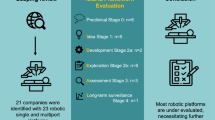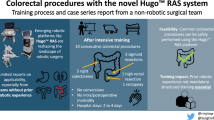Abstract
Background
Robotic surgery was invented to overcome the demerits of laparoscopic surgery. However, the role of robotic surgery in gastrectomy has rarely been reported. This study aimed to evaluate the use of robot-assisted distal subtotal gastrectomy to facilitate surgical training for gastric cancer.
Methods
Twenty gastric cancer patients who underwent robotic gastrectomy from July 2005 to November 2006 were compared with 20 initial patients who underwent laparoscopic subtotal gastrectomy from May 2003 to August 2003 and 20 recent patients who underwent laparoscopic subtotal gastrectomy during the same period as the 20 robotic gastrectomy procedures by the same surgeon.
Result
All 60 patients underwent subtotal gastrectomies with gastroduodenostomy without open or laparoscopic conversion. Operation time for robotic gastrectomy, initial laparoscopic gastrectomy, and recent laparoscopic gastrectomy was 230 min (range 171–312 min), 289.5 min (range 190–450 min), and 134.1 min (range 90–260 min). The number of retrieved lymph nodes was 35.3 ± 10.5, 31.5 ± 17.1, and 42.7 ± 14.9, respectively. Hospital stay was 5.7, 7.7, and 6.2 days, respectively. Postoperative complication occurred in two patients in recent laparoscopic gastrectomy and one patient each in robotic and initial laparoscopic gastrectomy.
Conclusion
In this context, it could be assumed that experienced laparoscopic surgeons could perform robotic gastrectomy with a certain level of skill, even in initial series.



Similar content being viewed by others
References
Adachi Y, Shiraishi N, Shiromizu A, Bandoh T, Aramaki M, Kitano S (2000) Laparoscopy-assisted Billroth I gastrectomy compared with conventional open gastrectomy. Arch Surg 135:806–810
Kitano S, Shiraishi N, Uyama I, Sugihara K, Tanigawa N (2007) A multicenter study on oncologic outcome of laparoscopic gastrectomy for early cancer in Japan. Ann Surg 245:68–72
Huscher CG, Mingoli A, Sgarzini G, Sansonetti A, Di Paola M, Recher A, Ponzano C (2005) Laparoscopic versus open subtotal gastrectomy for distal gastric cancer: five-year results of a randomized prospective trial. Ann Surg 241:232–237
Kim MC, Jung GJ, Kim HH (2005) Learning curve of laparoscopy-assisted distal gastrectomy with systemic lymphadenectomy for early gastric cancer. World J Gastroenterol 11:7508–7511
Jin SH, Kim DY, Kim H, Jeong IH, Kim MW, Cho YK, Han SU (2007) Multidimensional learning curve in laparoscopy-assisted gastrectomy for early gastric cancer. Surg Endosc 21:28–33
Suematsu Y, Kiaii B, Bainbridge DT, Del Nido PJ, Novick RJ (2007) Robotic-assisted closure of atrial septal defect under real-time three-dimensional echo guide: in vitro study. Eur J Cardiothorac Surg 32:573–576
Smith JM, Stein H, Engel AM, McDonough S, Lonneman L (2007) Totally endoscopic mitral valve repair using a robotic-controlled atrial retractor. Ann Thorac Surg 84:633–637
Patel VR, Thaly R, Shah K (2007) Robotic radical prostatectomy: outcomes of 500 cases. BJU Int 99:1109–1112
Veljovich DS, Paley PJ, Drescher CW, Everett EN, Shah C, Peters WAIII (2008) Robotic surgery in gynecologic oncology: program initiation and outcomes after the first year with comparison with laparotomy for endometrial cancer staging. Am J Obstet Gynecol 198:679.e1-9
Japanese Gastric Cancer Association (1998) Japanese Classification of Gastric Carcinoma—2nd English Edition. Gastric Cancer 1:10–24
Nakajima T (2002) Gastric cancer treatment guidelines in Japan. Gastric Cancer 5:1–5
Hyung WJ, Song C, Cheong JH, Choi SH, Noh SH (2005) Percutaneous needle decompression during laparoscopic gastric surgery: a simple alternative to nasogastric decompression. Yonsei Med J 46:648–651
Hyung WJ, Song C, Cheong JH, Choi SH, Noh SH (2007) Factors influencing operation time of laparoscopy-assisted distal subtotal gastrectomy: analysis of consecutive 100 initial cases. Eur J Surg Oncol 33:314–319
Heemskerk J, van Gemert WG, de Vries J, Greve J, Bouvy ND (2007) Learning curves of robot-assisted laparoscopic surgery compared with conventional laparoscopic surgery: an experimental study evaluating skill acquisition of robot-assisted laparoscopic tasks compared with conventional laparoscopic tasks in inexperienced users. Surg Laparosc Endosc Percutan Tech 17:171–174
Bodner J, Wykypiel H, Wetscher G, Schmid T (2004) First experiences with the da Vinci operating robot in thoracic surgery. Eur J Cardiothorac Surg 25:844–851
Zorn KC, Orvieto MA, Gong EM, Mikhail AA, Gofrit ON, Zagaja GP, Shalhav AL (2007) Robotic radical prostatectomy learning curve of a fellowship-trained laparoscopic surgeon. J Endourol 21:441–447
Matsunaga GS, Ahlering TE, Skarecky DW (2006) Update on robotic laparoscopic radical prostatectomy. Sci World J 6:2542–2552
Yohannes P, Rotariu P, Pinto P, Smith AD, Lee BR (2002) Comparison of robotic versus laparoscopic skills: is there a difference in the learning curve? Urology 60:39–45
Diks J, Nio D, Jongkind V, Cuesta MA, Rauwerda JA, Wisselink W (2007) Robot-assisted laparoscopic surgery of the infrarenal aorta : the early learning curve. Surg Endosc 21:1760–1763
Vidovszky TJ, Smith W, Ghosh J, Ali MR (2006) Robotic cholecystectomy: learning curve, advantages, and limitations. J Surg Res 136:172–178
D’Annibale A, Morpurgo E, Fiscon V, Trevisan P, Sovernigo G, Orsini C, Guidolin D (2004) Robotic and laparoscopic surgery for treatment of colorectal diseases. Dis Colon Rectum 47:2162–2168
Giulianotti PC, Coratti A, Angelini M, Sbrana F, Cecconi S, Balestracci T, Caravaglios G (2003) Robotics in general surgery: personal experience in a large community hospital. Arch Surg 138:777–784
Author information
Authors and Affiliations
Corresponding author
Rights and permissions
About this article
Cite this article
Song, J., Kang, W.H., Oh, S.J. et al. Role of robotic gastrectomy using da Vinci system compared with laparoscopic gastrectomy: initial experience of 20 consecutive cases. Surg Endosc 23, 1204–1211 (2009). https://doi.org/10.1007/s00464-009-0351-4
Received:
Revised:
Accepted:
Published:
Issue Date:
DOI: https://doi.org/10.1007/s00464-009-0351-4




